
Everything in this slideshow
-
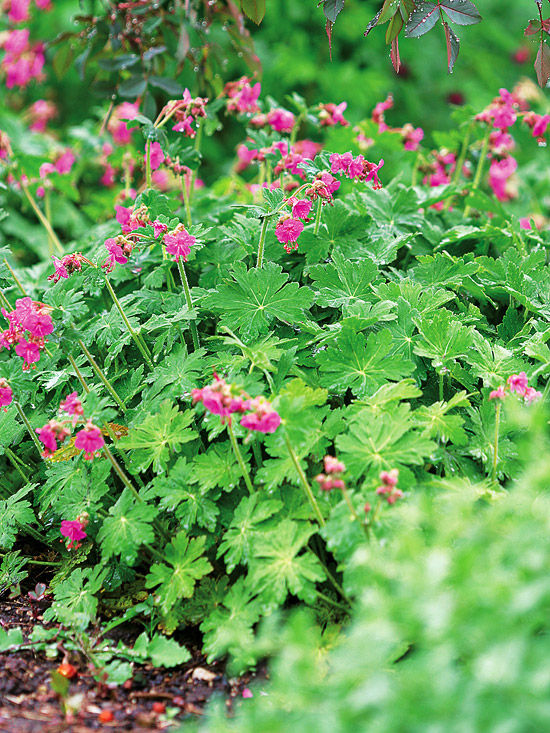
Bigroot Geranium
One of the toughest plants that grow in the shade garden, bigroot geranium (Geranium macrorrhizum) doesn’t mind heat or drought. And, deer and rabbits typically pass it by in search of tastier morsels. This shade plant puts on a spring show with pink or white flowers; some varieties also offer outstanding fall coloration in their woodsy-scented foliage. Bigroot geranium is hardy in Zones 4-8 and grows 2 feet tall.
Top Picks: ‘Album’ offers white flowers; ‘Ingwersen’s Variety’ offers clear pink flowers; ‘Variegatum’ has purple-pink flowers and white-variegated leaves.
Plant it with: Add height and interest to your shade garden by planting bigroot geranium in front of toad lilies.
- Learn more about bigroot geranium.
- Get garden tips and plant suggestions specific to your region.
-
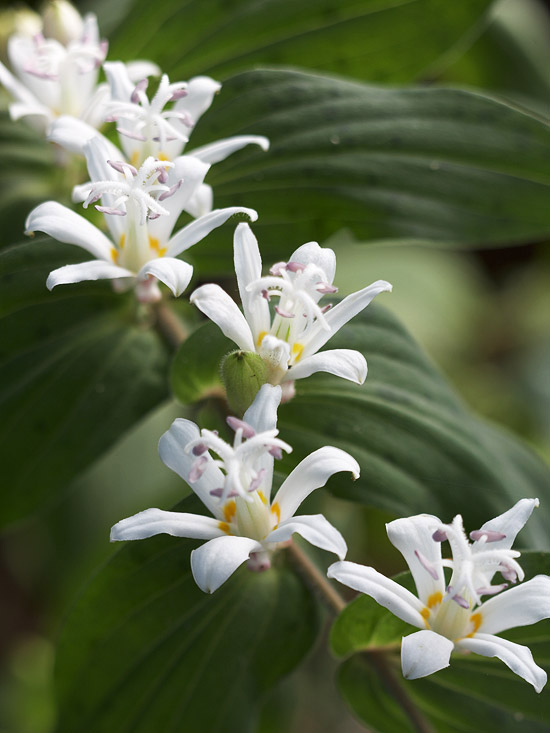
Toad Lily
Put on a fall show with shade plant toad lily (Tricyrtis). This easy-to-grow perennial offers unique flowers that are often compared to orchids. Many are spotted with shades of purple or blue.
Top Picks: ‘White Towers’ bears white flowers; ‘Tojen’ offers especially large lavender flowers.
Plant it with: Let toad lily rise up behind a clump of medium-sized hostas or fern-leafed bleeding heart.
- Learn more about toad lily.
-
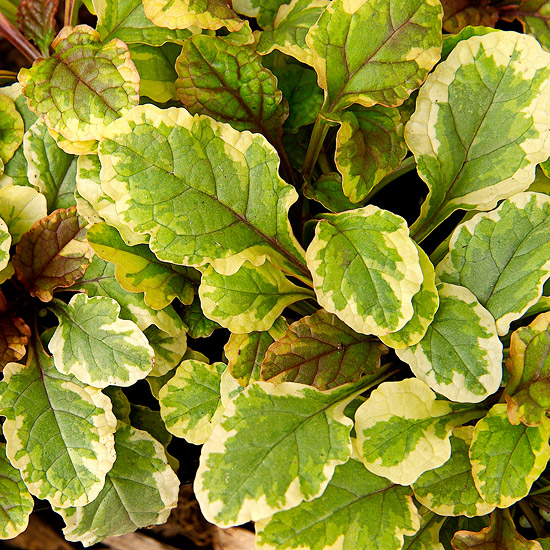
Ajuga
This topnotch groundcover is grown mainly for its foliage, but also has pretty flowers. Ajuga produces glossy, dark green leaves and springtime spikes of blue flowers. Select varieties of this shade plant offer dark purple or variegated foliage, or pink or white flowers. Ajuga grows best in Zones 3-9 and grows only 6 inches tall.
Test Garden Tip: Ajuga can be a vigorous spreader; it’s not the best choice for small spaces.
Top Picks: ‘Golden Glow’ has creamy-yellow edges; ‘Black Scallop’ offers shiny, dark purple leaves and fragrant blue flowers; ‘Burgundy Glow’ offers silvery-green leaves splashed with pink and burgundy; ‘Chocolate Chip’ offers smaller, purple-infused leaves.
Plant it with: Purple-leafed ajuga varieties look great against blue hostas.
- Learn more about ajuga.
-
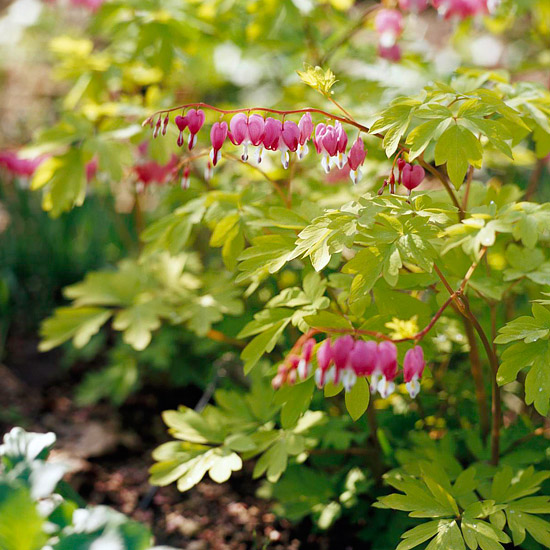
Old-Fashioned Bleeding Heart
There’s little wonder why old-fashioned bleeding heart (Dicentra spectabilis) is a favorite of plants that grow in shade. In late spring and early summer, it produces pink or white heart-shaped flowers that hang from elegant, arching stems. This top-notch shade plant is hardy in Zones 3-9 and grows up to 4 feet tall.
Test Garden Tip: By midsummer, old-fashioned bleeding heart usually goes dormant and loses its foliage. Plant it with astilbe or hosta so you don’t end up with a bare spot in your garden.
Top Picks: ‘Pantaloons’ is a variety with large numbers of pure white flowers. ‘Gold Heart’ bears bright golden leaves against the pink flowers.
- Don’t miss out! Buy bleeding heart from our Garden Store.
- More on bleeding hearts
-
Top Shade Garden Plants
Discover beautiful and easy-to-grow shade plants to add color and interest to shaded spots in your garden or landscape.
-
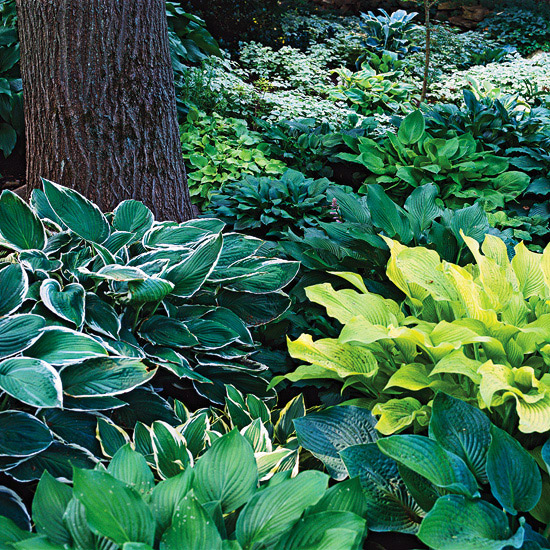
Hosta
Hostas are among the showiest and easy-to-grow perennial plants that grow in shade. They also offer the most variety of any of the multiple shade plants. Choose from miniatures that stay only a couple of inches wide or giants that sprawl 6 feet across or more. Look for leaves in shades of green, blue, white, chartreuse, and gold, with many cultivars being variegated. Some hosta flowers are very fragrant. Hostas are hardy in Zones 3-8.
Top picks: ‘Blue Mouse Ears’ offers silvery-blue leaves and stays 1 foot wide; ‘Frances Williams’ offers thick, blue-green leaves edged in chartreuse and grows 2 feet wide; ‘Sum and Substance’ offers chartreuse leaves and grows 6 feet wide.
Plant it with: Old-fashioned bleeding heart, which typically goes dormant in summer.
- Buy hostas now from our Garden Store!
- Learn more about hostas.
- See our list of long-living perennials.
-
Our Favorite Shade Perennials
See some of our all-time top perennials for shade.
-
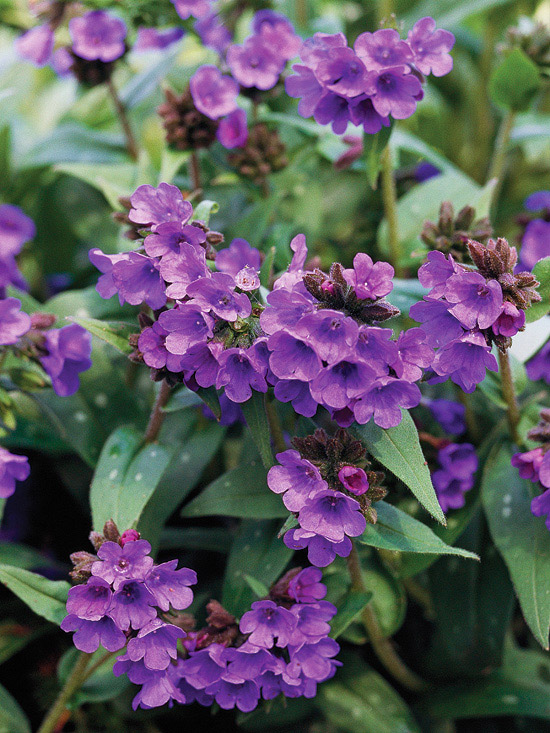
Lungwort
A great plant with an unfortunate name, lungwort (Pulmonaria) earned its moniker from the silvery, lung-shaped spots that dot the foliage of these plants that grow in shade. The variegated foliage looks great all season long, but is an especially nice accent to the clusters of pink, white, or blue flowers in spring. Lungwort grows best in Zones 4-8 and reaches 1 foot tall.
Test Garden Tip: Because its foliage is somewhat hairy, deer and rabbits typically leave lungwort alone.
Top picks: ‘Opal’ features ice-blue flowers; ‘Trevi Fountain’ features cobalt-blue blooms.
Plant it with: Japanese painted fern or ‘Jack Frost’ brunnera for a delightful silver-on-silver play.
- Don’t miss out on growing lungwort in your garden: Order it from our Garden Store now!
- Learn more about lungwort.
-
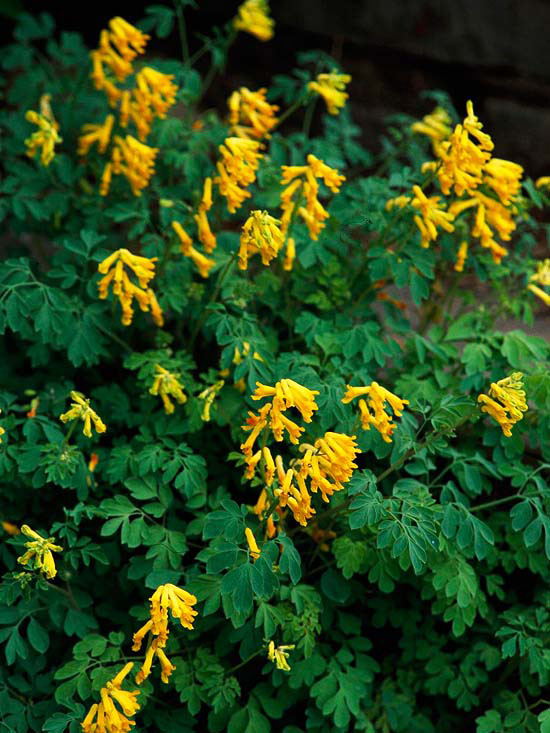
Yellow Corydalis
This hard-working perennial plant that grows in shade takes the prize for being the longest bloomer in the sheltered garden. Enjoy its clusters of yellow flowers from late spring all the way to frost. It’s not just the flowers that are beautiful; the gray-green leaves of these shade plants are attractive as well. The plant grows about 12 inches tall and is hardy in Zones 5-8.
Test Garden Tip: This plant can be a prolific self-seeder.
Top picks: Corydalis lutea is the easiest to grow and the longest blooming. White corydalis (Corydalis ochroleuca) also flowers over an extended period.
Plant it with: Accent the plant’s bright flowers against dark green hellebore or hosta foliage.
- Like this variety? Order corydalis in blue from our Garden Store.
- Learn more about corydalis.
-
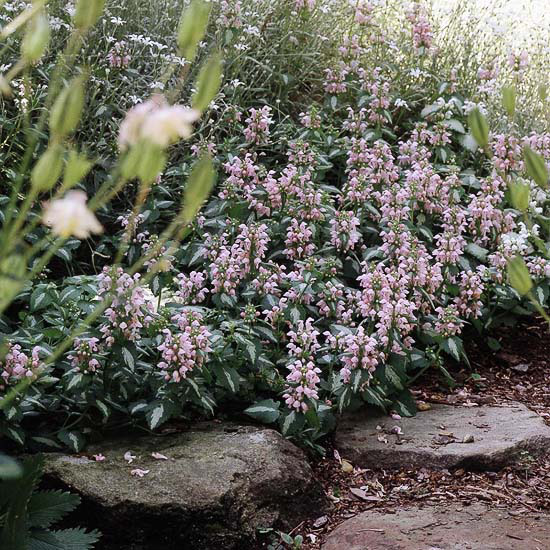
Lamium
Starting in mid-spring, Lamium produces clusters of pink or white flowers. This delightful groundcover can rebloom off and on through the summer, creating months of color. And even when its not blooming, the silver-infused foliage of these shade plants brighten up shady corners. Lamium usually stays about 8 inches tall and grows best in Zones 4-8.
Tip: Keep lamium looking good by keeping it moist. If it dries out too much, the leaves will develop brown edges.
Top picks: ‘White Nancy’ offers white flowers and silver foliage with a green edge; ‘Beacon Silver’ bears pink flowers and silvery leaves.
Plant it with: Let lamium cover the ground underneath a colony of martagon lilies or an understory tree such as a redbud.
- Order lamium now for your garden!
- Learn more about lamium.
-
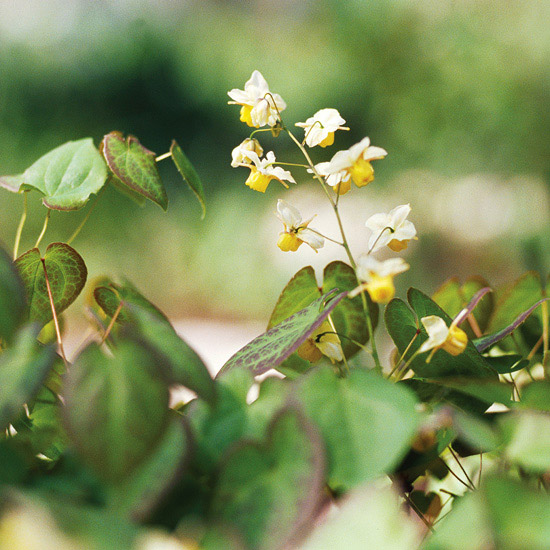
Epimedium
An under-used plant that grows in shade that deserves a lot more attention, Epimedium has it all when it comes to shade plants. The groundcover blooms in spring in shades of red, orange, yellow, pink, purple, or white; it tolerates dry shade; and it’s deer- and rabbit resistant. Some varieties are evergreen in mild-winter areas; others offer good fall color. Most types grow best in Zones 5-9 and reach about 1 foot tall.
Top Picks: ‘Niveum’ offers pure white flowers; ‘Sulfureum’ offers yellow blooms.
Plant it with: Create delightful contrast with epimedium’s shield-shaped foliage against the lacy leaves of yellow corydalis.
- Add epimedium to your garden this year. Buy now from our store.
- Learn more about epimedium.
-
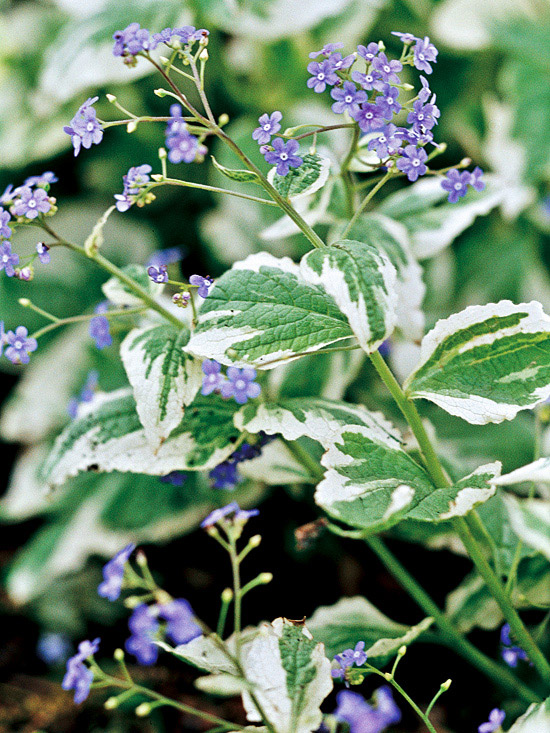
Brunnera
In spring, shade gardens sparkle with the sky-blue flowers of Brunnera. When not in bloom, its large, robustly textured leaves continue to look great — especially if you grow a variegated type of these shade plants. While the plant is often short-lived, it does tend to self-seed, becoming a long-term presence in the garden.
Test Garden Tip: Brunnera is somewhat deer- and rabbit resistant.
Top Picks: ‘Hadspen Cream’ offers green leaves broadly edged in creamy white; ‘Jack Frost’ has green leaves heavily overlaid with silver.
Plant it with: Go for a lovely blue-on-blue combination with forget-me-not.
- Order brunnera from our garden store.
- Learn more about brunnera.
-
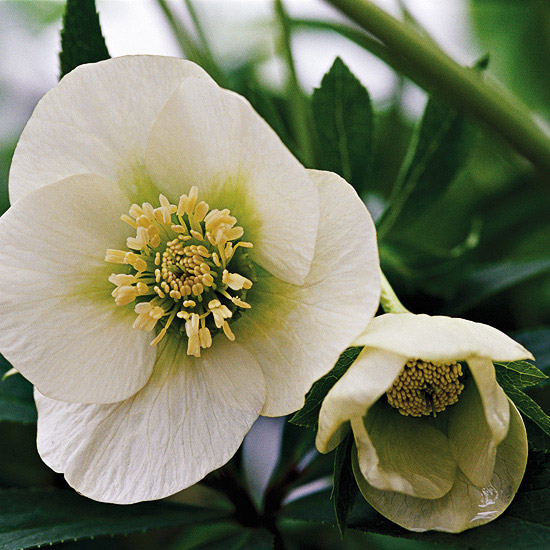
Hellebore
Hellebore (Helleborus), also called Christmas rose, is one of the earliest bloomers of plants that grow in shade. Look for its burgundy, pink, cream, green, or white flowers in late winter or early spring. Although it looks delicate, the Christmas rose is quite sturdy once it gets established. And, it’s deer- and rabbit-resistant. Hellebore grows best in Zones 4-8 and grows 12 inches tall.
Top Picks: The Heronswood Double strain offers frilly, petal-packed blooms in a wide range of colors; the Royal Heritage strain offers single blooms in a wide range of colors.
Plant it with: Gold-leaf coralbells such as ‘Lime Rickey’ or ‘Citronelle’, which will shine even brighter against dark green hellebore leaves.
- Order hellebores now for your garden!
- Learn more about hellebores.
-
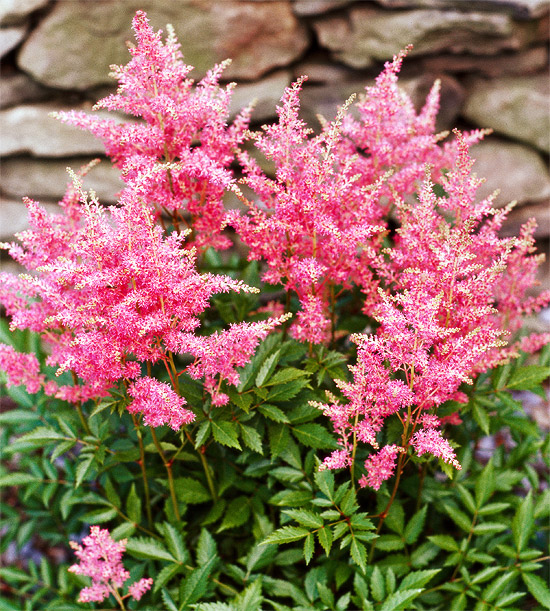
Astilbe
Enjoy the feathery plumes of Astilbe in early summer. This tough perennial blooms in shades of burgundy, red, pink, lavender, and white. In addition to the attractive flowers, these shade plants have finely cut foliage, which in many varieties is flushed with bronze. Astilbe grows best in Zones 4-8 and can reach up to 4 feet tall, depending on variety.
Test Garden Tip: Astilbe needs consistently moist soil to thrive, so it’s a good choice for areas that don’t drain well.
Top Picks: ‘Deutschland’ bears pure white flowers; ‘Fanal’ offers dark red plums and bronzy foliage; ‘Sprite’ is an award-winning selection with shell-pink blooms.
Plant it with: ‘Britt-Marie Crawford’ ligularia, which features dramatic purple foliage and golden-orange flowers. It also prefers wet soil.
- Love it? Buy ‘Fanal’ astilbe now from our Garden Store!
- Learn more about astilbe.
-
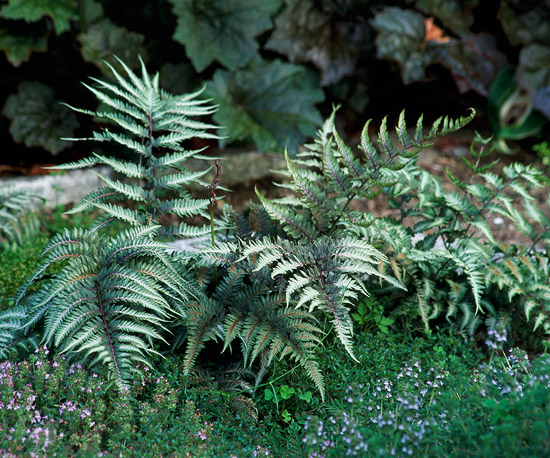
Japanese Painted Fern
It’s tough to imagine lovelier shade plants than Japanese painted ferns (Athyrium niponicum var. pictum). This beauty offers fronds liberally dappled with silver, burgundy, and green. Plus, it’s a low-growing, slow-spreading plant that grows in shade. And, deer and rabbits usually leave it alone. It grows best in Zones 5-8 and gets about 12 inches tall.
Top picks: ‘Silver Falls’ has especially metallic leaves; ‘Burgundy Lace’ has lots of rich purple-red tones in the leaves.
Plant it with: ‘Burgundy Glow’ ajuga or ‘Green Spice’ coralbells — all have silvery and purple tones in their foliage.
- Don’t miss out — order Japanese painted fern now!
- Learn more about Japanese painted fern.
- Wet soil? See the perfect perennials for your garden.
-
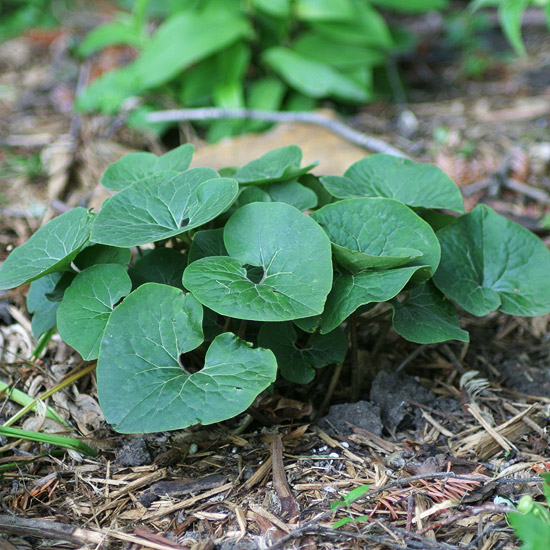
Wild Ginger
Hailing from the woodlands of North America, wild ginger (Asarum canadense) is one tough shade plant. It produces fuzzy, heart-shaped leaves that look great from spring to fall. And, it’s rarely bothered by deer and rabbits. This slow grower eventually forms an impressive clump. It grows best in Zones 2-8 and reaches 6 inches tall.
Top Picks: Wild ginger is a lovely deciduous type. European wild ginger (Asarum europaeum) offers shiny evergreen heart-shape leaves. Zones 4-8.
Plant it with: Wild ginger looks beautiful with fern-leaf bleeding heart.
- Buy European wild ginger now!
- Learn more about wild ginger.
-
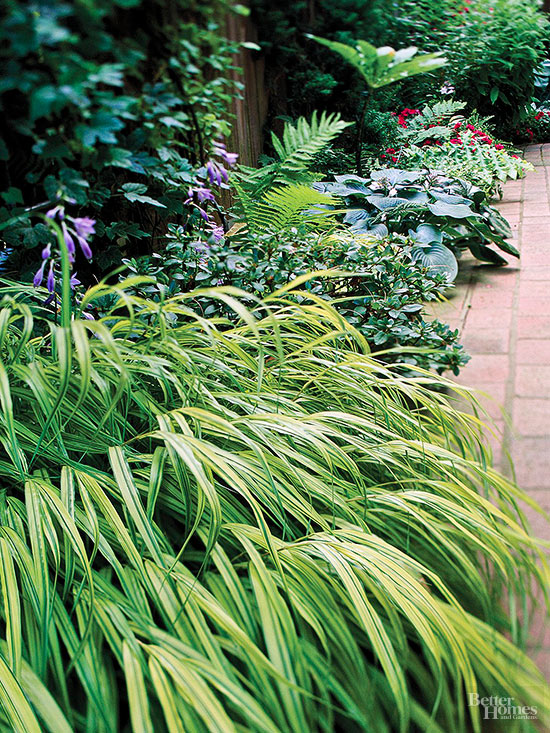
Japanese Forestgrass
Japanese forestgrass (Hakonechloa macra) is a wonderful grass for plants that grow in shade. It offers a lovely waterfall-like habit and variegated varieties have bight gold, yellow, or white in the foliage. In fall, the leaves of these shade plants usually pick up beautiful reddish tones. It grows best in Zones 5-9 and grows a foot tall.
Top Picks: ‘Aureola’ bears bright yellow leaves with dark green edges; ‘All Gold’ has even brighter golden foliage.
Plant it with: Add zing to a shady corner by planting Japanese forestgrass with a bold, golden hosta.
- ‘Hakonechloa macra’: Buy it now from our Garden Store!
- Learn more about Japanese forestgrass.
-
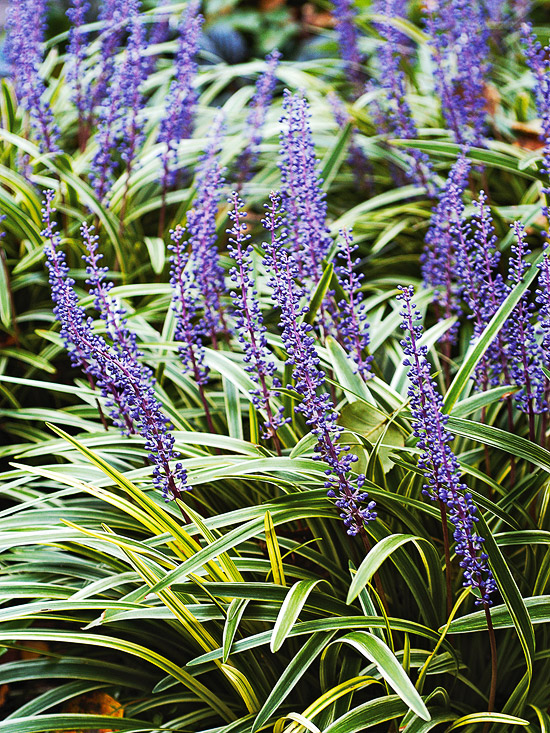
Lilyturf
Lilyturf (Liriope) is an easy-to-grow favorite shade plant. Loved for its grassy foliage and spikes of blue or white flowers in late summer, as well as its resistance to deer and rabbits, lilyturf is practically a plant-it-and-forget garden resident. It grows best in Zones 5-10 and grows a foot tall.
Test Garden Tip: Lilyturf can be a fast, almost aggressive spreader when it’s happy.
Top Picks: ‘Majestic’ offers narrower leaves and deep purple-blue flowers; ‘Silver Dragon’ offers boldly variegated foliage and violet-blue blooms.
Plant it with: Create an interesting look by planting Japanese forestgrass with a deep green lilyturf.
- Don’t miss out on growing lilyturf in your garden: Order it from our Garden store now!
- Learn more about lilyturf.
-
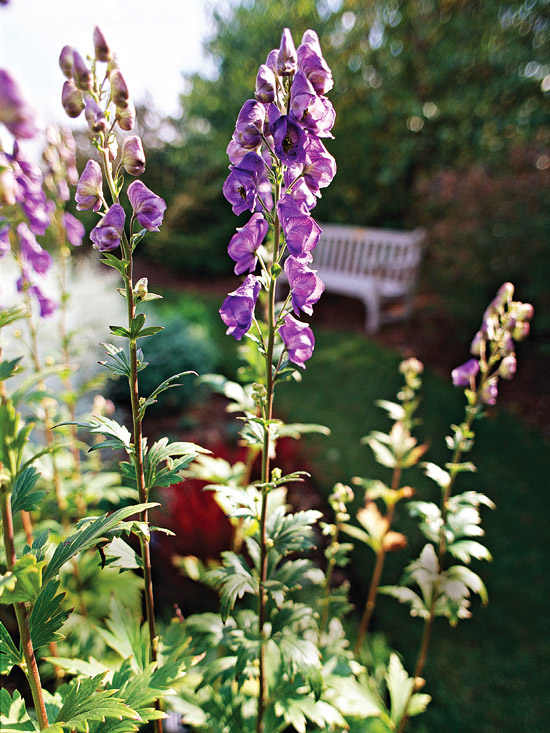
Monkshood
Monkshood (Aconitum) is a noteworthy plant that grows in shade because it blooms in late summer, when most other shade bloomers have finished. Plus, it’s deer- and rabbit-resistant. Named for its drooping blue flowers that resemble the hood on a monk’s robe, this lovely shade plant is an easy, under-used plant. It grows best in Zones 3-7 and grows up to 6 feet tall.
Top Picks: ‘Bressingham Spire’ offers violet-blue flowers on 3-foot-tall plants; ‘Stainless Steel’ offers steel-blue flowers on 4-foot-tall plants.
Plant it with: Kirengeshoma, a beautiful, but under-used perennial with bold foliage and yellow flowers in late summer.
- Learn more about monkshood.
-
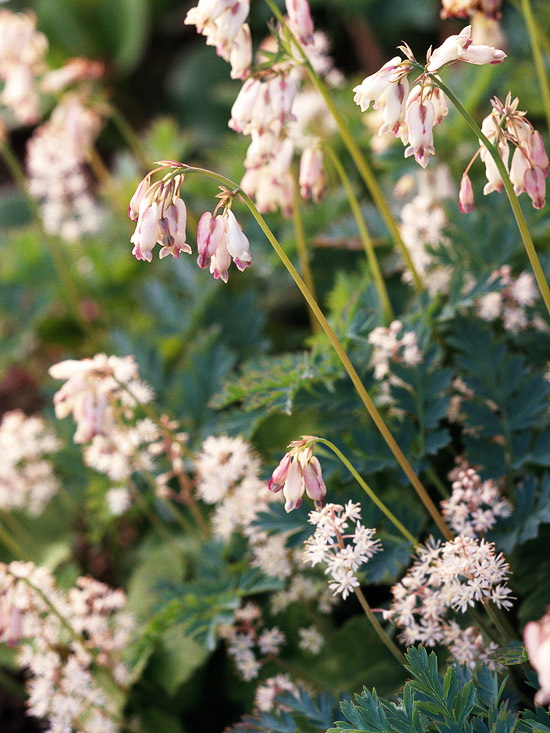
Fern-Leaf Bleeding Heart
Fern-leaf bleeding heart (Dicentra eximia and D. formosa) look beautiful all season. These shade plants bloom on and off from spring to fall (if they get enough moisture during hot, dry periods), producing delicate clusters of pink, red, or white flowers. Even when not in bloom, though, their tidy mounds of blue-green, ferny foliage looks great. They grow best in Zones 4-8 and grow up to 2 feet tall.
Top Picks: ‘Bacchanal’ offers dark red flowers; ‘King of Hearts’ offers rose-pink flowers and stays about 1 foot tall; ‘Aurora’ offers white blooms.
Plant it with: Create a subtle contrast by planting fern-leaf bleeding heart with yellow corydalis.
- Learn more about fern-leafed bleeding heart.
-

SOURCE:http://www.bhg.com/gardening/flowers/perennials/the-best-perennials-for-shade/